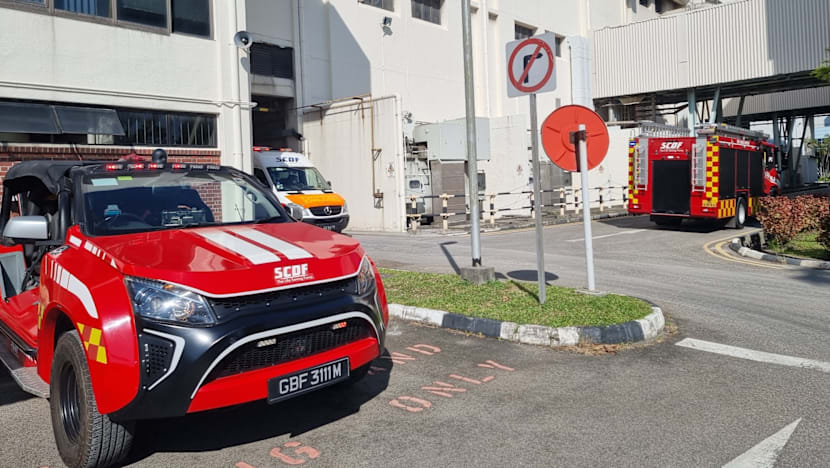NEA fined S$230,000 over deaths of 2 employees in Tuas Incineration Plant explosion
Mr Kwok Yeow Wai and Mr Wee Eng Leng died in an explosion at Tuas Incineration Plant in September 2021 after being sent there to troubleshoot a faulty industrial fan.

SCDF vehicles at the Tuas Incineration Plant on Sep 23, 2021. (Photo: Facebook/Singapore Civil Defence Force)

This audio is generated by an AI tool.
SINGAPORE: The National Environment Agency (NEA) was on Tuesday (Nov 18) fined S$230,000 (US$176,500) for work safety failures that contributed to the death of two of its officers at Tuas Incineration Plant in 2021.
Mr Kwok Yeow Wai, 65, and Mr Wee Eng Leng, 64, died when an explosion occurred in an electrical switch room where they had been sent to troubleshoot a fault.
A third employee, Mr Low Yin Choon, 59, survived the blast with injuries.
The incident occurred on Sep 23, 2021, when the three men were called in to troubleshoot an industrial fan in the incineration plant that could not be switched off.
After unsuccessful attempts to switch the industrial fan off remotely, they went to the switch room to try to do this.
While Mr Kwok and Mr Wee were at the switch trying to trip the circuit breaker, Mr Low went to the other end of the room and called the central control room to check the readings of the current.
The operator informed him that the current flowing into the industrial fan had surged. Mr Low was shocked to hear this as he knew that this would damage the fan, and hurried back to the switch.
At this time, either Mr Kwok or Mr Wee disconnected the circuit breaker from the switch while a live current was still flowing. This "racking out" with a live current was against safety regulations.
It resulted in an arc flash explosion - an electrical blast caused by a short circuit through the air - in the switch room. All three men, who were not wearing suitable fire-retardant gear, were injured in the blast.
Mr Kwok was pronounced dead at the scene and Mr Wee died in hospital three days later. Mr Low was hospitalised with severe burns over 27 per cent of his body surface area.
A forensic examination found another factor leading to the blast - the automatic tripping, which was a safety feature, did not occur because a piston in the circuit breaker had worn out over time and dislodged, jamming the mechanism.
Defence counsel Mr Jason Chan told the court that the incident was "deeply painful" for the agency. "Mr Kwok and Mr Wee were cherished and very senior employees of NEA," said the lawyer.
Mr Kwok was a senior engineering manager and head of the Electrical Maintenance Branch (EMB). Mr Wee was an executive engineering manager in the EMB. Each had more than 40 years of experience in electrical maintenance work at the time.
In a statement after the hearing, NEA said it deeply regretted the loss of the two long-serving NEA officers.
"Even after four years, their absence continues to be deeply felt, and their contributions will be remembered. We are thankful that the officer who suffered injuries has since recovered and returned to work," the agency said.
NEA added that it took responsibility for the shortcomings cited in the case and accepted the fine. It also detailed steps it has taken to strengthen workplace safety practices and culture beyond the shortcomings in the criminal charge.
"NEA regrets that we had fallen short of the high standards we set for ourselves and the expectations of the public. We will strive to put in our utmost efforts to do better in the future," it said.
THREE WORK SAFETY FAILURES
The statutory board was represented in court by its group director of infrastructure and engineering Desmond Tan.
NEA pleaded guilty to one charge under the Workplace Safety and Health Act, covering three work safety failures.
First, NEA did not ensure that its permit-to-work system for high-voltage switchgear racking works complied with Electricity (Electrical Installations) Regulations.
According to regulations, only an authorised engineer can issue the permit to work, and the permit must be issued to "competent persons".
But on the day of the incident, the permit to work was not issued by the authorised engineer. He was not notified of the faulty industrial fan and was not asked to issue any permit.
Mr Kwok and Mr Wee were also not "competent persons" to carry out such works.
The prosecution said this happened because NEA's permit-to-work system did not expressly require the authorised engineer to issue the permit, and charged other engineers with doing this even though they were not authorised.
The authorised engineer was also supposed to supervise such works or delegate supervision to another competent person. But this did not happen on the day, as he was not notified of the EMB team's intended works.
Investigations further found that the EMB team had been carrying out high-voltage switchgear racking works without the supervision of an authorised engineer for several years.
Second, NEA did not provide maintenance workers at Tuas Incineration Plant with suitable personal protective equipment, which should have included fire-retardant clothing.
This was despite NEA identifying the risk of flashover and burns in its own risk assessment.
Instead, the workers wore an NEA-issued uniform that had no fire-retardant qualities. NEA also provided them with helmets, goggles, gloves and safety shields.
At the time of the explosion, all three men were wearing their uniforms and safety boots. Mr Kwok and Mr Wee also wore helmets.
Third, NEA did not establish safe work procedures for the type of work that the team was carrying out on the day, therefore failing to control foreseeable risks.
ARGUMENTS ON WHETHER NEA CAUSED INCIDENT
The prosecution called for a fine of between S$240,000 and S$270,000.
Defence lawyer Mr Chan argued that even though NEA accepted its safety lapses, these did not cause the fatal incident, which was "unprecedented and unexpected".
The permit to work was issued to the engineers for troubleshooting, and it was "never contemplated" they would rack out the circuit breaker with a live current, he argued.
The piston, which was dislodged after becoming worn out over time, was also well within its lifespan of use, having been used in 645 switching operations.
It was meant to be inspected every 10,000 operations and replaced every 30,000 operations. This was hence not a failure of maintenance or inspection on NEA's part, he said.
Deputy Public Prosecutor Agnes Chan countered that there was no need to show the blast was the "direct outcome" of NEA's lapses in order to set out the causation.
"The relevant question for this court is: why were the EMB team allowed and able to carry out the live racking in the switchgear room in the first place?" she asked.
NEA's defective permit-to-work system failed to carry out its essential gatekeeping function, and the permit to work did not set limits on the scope of works the EMB team could perform, argued Ms Chan.
She also said that safe work procedures were needed precisely because missteps like those by the EMB team on the day were foreseeable.
Deputy Principal District Judge Luke Tan asked whether warning stickers on the switch as well as safety instructions in a 1998 manual counted as establishing safe work procedures. The defence had raised these earlier.
Ms Chan replied that safe work procedures are a "beacon of safety" and cannot be a "hodgepodge" of information, and that the earlier manual was not made known to officers.
She noted that in contrast, after the incident, NEA established a set of safe work procedures with detailed steps and pictures that was disseminated to officers.
The defence also sought to explain why the EMB team was only given basic protective gear to wear. Mr Chan said NEA relied on its authorised engineer, who is a licensed electrical worker.
The basic gear was consistent with what the authorised engineer wore when carrying out works, and with what he identified for NEA during safety training, said Mr Chan.
RECTIFICATION OF FAILURES
The prosecution noted that NEA has since rectified each of these failures after the incident.
Only licensed electrical workers and competent persons can now carry out high-voltage switchgear racking works. The work functions of the engineering team involved in the incident were limited.
NEA also moved to prescribe suitable safety gear, including an arc flash protection suit, and established and disseminated safe work procedures for such works.
Deputy Principal District Judge Luke Tan took NEA's post-incident response into consideration in reducing the sentence.
He said this included measures that exceed regulatory requirements, such as setting up a panel of licensed electrical workers to advise on works involving high-voltage equipment.
NEA said in its statement that it is now advised by an external advisory panel of senior industry leaders with experience managing large facilities and operations, in a bid to strengthen safety at all its waste management facilities.
"NEA has also set up a dedicated unit to drive safety and continuous improvement, as well as appointed an external consultant to benchmark and recommend further improvements to safety systems and processes at our waste management facilities," said the agency.
In 2023, the NEA Board was restructured to include a dedicated risk committee to oversee and manage key risks including workplace safety. Last year, NEA set up a dedicated workplace safety and health division.
Tuas Incineration Plant was decommissioned in 2022 after 36 years of operations. It is undergoing demolition.
Two other NEA employees have also been charged with work safety failures. Their cases are still before the courts.
They are Ng Wah Yong, the general manager of Tuas Incineration Plant, and another NEA officer, Christopher Lee Yew Binn.
NEA previously said that both men were redeployed to non-operational roles pending the outcome of the legal proceedings.
On Tuesday, the agency said it would work with the Ministry of Sustainability and the Environment to study the court's findings and assess how they should be reflected in the officers' personnel matters after their cases have concluded.
NEA asked the court for time to pay the fine and was given five working days. It must pay the fine by Nov 25. Compensation has already been paid under the Work Injury Compensation Act, the prosecution told the court.
In response to queries from CNA, NEA said the fine, like those paid by other corporate bodies, would form part of an organisation's operating expenditure. The fine will be paid to the State Courts.
CNA also asked whether this would affect the budget for any public projects. NEA said it "will continue to provide our public services and operations and ensure that service standards are not compromised".
The agency could have been fined up to S$500,000 for failing to take the necessary measures to ensure the safety and health of employees at work.















